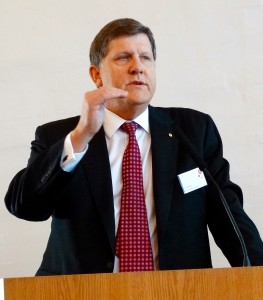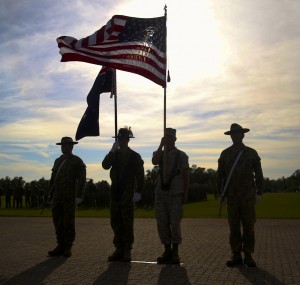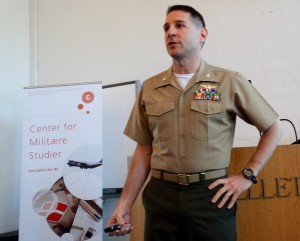2015-04-25 By an historical anomaly more than strategic planning, the USMC and the RAAF find themselves in similar situations in one key regard: both are undergoing fundamental modernization of their air platforms, and are approaching the re-set not from a platform-centric mentality but a transformation approach.
Prior to the airpower symposium in Copenhagen, we had a chance to sit down with Air Vice-Marshal (Retired) John Blackburn and Lt. Col. “Chip” Berke and discuss with them the way ahead and the challenge of innovation in shaping 21st century approaches.
Blackburn was the co-chair of the conference and Berke was a speaker focusing on his air operations experience through multiple settings with the F-18, F-16, operating as a JTAC, and then operating the F-22, the F-35 and becoming the CO of the Warlords. Berke is currently studying in Washington DC and preparing for a Pentagon tour.
We started with Blackburn and he focused on what the RAAF Chief of Staff calls Plan Jericho to get a sense of the focus on transformation for the RAAF and the Australian defense forces.
Question: What has been the trigger for Plan Jericho?
Blackburn: The decision to acquire F-35 triggered the rethink.
The significant advances the F-35 offers to the combat force needs to be matched by similar type of advances in situational awareness an the ability to operate as a team across the whole force.
How are we going to use our legacy systems, and those new platforms we are bringing into the force in an innovative way to shape new capabilities and concepts of operations?
From our dealings with the Marines in Australia and elsewhere, it was obvious that they were thinking along similar lines.
The Marines are truly joint in the Australian terms, and like us, they are not waiting for new systems to come into play prior to shaping a new approach to combat innovation.

They are shaping the template as new platforms – in this case the F-35 comes into play.
They have put several years of work into thinking about and doing combat innovations prior to the F-35 entering their force.
This is the way we are approaching the challenge and opportunity as well.
Question: Because of the constant barrage of criticism leveled at the F-35, and that for many people the thinking is about one to one replacement platforms for 20th century forces going into the future, have you find much thinking about a comprehensive reset of combat approaches associated with the aircraft?
Blackburn: Fundamentally there is a huge intellectual void.
We think of the F-35 not as a replacement aircraft but a trigger to a fundamental rethink about the shaping of 21st century approaches to combat and warfare.
Unfortunately, much of the thinking out there is trapped in the 20th century is platform replacement centric and really is not getting on with transformation.
When the Jericho team was first set up earlier this year the fundamental question posed to them was: how do we explore the future concept of operations?
And then another key question: “What is the role of each of the fighting elements in this future combat environment?”
This is not just about an airplane or the air force; it is about the Australian fighting force as a whole.
Question: The Chief of Staff of the RAAF clearly highlighted that you have made your basic platform decisions and it was now time to think about how they work together.
This must mean that a key part of innovation will also go to the enablers?
Blackburn: Exactly.
Industry likes to sell you replacement platforms; they do not often focus on the platforms and the enablers as a system.
How do all the other enabling pieces, everything from training to selection to the supporting elements, the logistics, how is that going to work in this fifth generation force?
The concept is really one of the key things that’s being worked right now.
Along with that, we had to have a narrative that describes the 5th Generation force we want to be.
What is fifth generation enabled force?
The definition the RAAF Chief has used is to make sure it means something not just to the Air Force, but also to the Army and to the Navy.
It is that a force with vastly improved shared situation awareness and the ability to operate as an integrated team.
The connectivity and fusion thinking is central to the ability to operate far more effectively as an integrated team.
The Australian Defense Minister used that terminology about two weeks ago in a major speech he gave in Australia.
He wants Australia’s Defence force to be a fifth generation force.
Clearly, it is not just about connecting everybody; it is about tailoring the information appropriate to the engaged force and to the decision makers at the appropriate level to lead the force.
The RAAF are going to put the enablers through a number of demonstration projects to find what works, and the most effective ways to shape a more effective force, rather than chasing the next platform acquisition.

Question: Chip, you have heard John and what is your sense of the importance of what the RAAF is now focused upon?
Berke: To be honest, it is refreshing to hear the language and the conversation we are having now.
There’s a compulsion, when you talk about a replacement aircraft, is to just apply the templates that we’re comfortable with and apply the philosophies that we’re familiar with and just sort of overlay that on top of the hardware, the equipment.
And with the fifth generation aircraft, this just does not apply.
I think if people don’t commit to the idea that the platform is revolutionary, the platform is unique, the platform reveals capabilities that didn’t exist before and can transform war fighting, then you’re never going to get to the next phase of what does it mean for the overall force.
I think there’s a burden of generating commitment that one individual asset can actually be the impetus to change the way the force sees integrative war fighting.
The Marine Corps I think has had a similar experience the Air Force has had with the Raptor and the Eagle, with the V-22.
The V-22 is a replacement for the CH46.
You can make that argument.
You can say that, but I think once you see the V-22, you overlay the CH46 template on it and I think it doesn’t take a lot of time to realize that that path makes no sense at all.
I think that’s human nature, it’s our compulsion, to take what we know and take this new thing and put it together with an older one.
There is a chronological connection between the CH46 and the V-22, but that is about it.
In the time continuum, yes, the V-22 replaced the CH46. That’s about where it ends in terms of capability and impacts.

Question: You have flown several legacy aircraft, and the F-22 as well as F-35. How does your CH-46 to V-22 analogy apply?
Berke: The F35 is here but you often here: “Well, we’re going to replace the F18 with that, and the Harrier, we’re going to replace the F16 and the A10.”
For me, that has always been a red flag because of my experience in the Raptor where the Air Force originally acted like it was an F-15 replacement.
It is not.
Benefiting from being in a community that had already come to grips with the idea that the Eagle Raptor replacement was wrong, it is clear the F-35 is not replacing anything – it is a whole new way to operate.
The USAF basically had to start over, sort of admit that they’d spun their wheels for a couple of years and tried to apply the Eagle template.
They copied and pasted Eagle with the Raptor in the Weapons School publications.
The ranges, the way they flew, the way they interacted with everybody else, looked very similar for a while.
At some point, they just cut bait on that and realized it was the wrong way to do it, and they were forced to accelerate the evolution of the airplane once they came to grips with the fact that is was not a step change from the Eagle.
Now we are in a similar position with the F35, but because it sort of looks and sounds and smells like a fighter, there’s this compulsion to look at it like a fighter.
One of the things I constantly try to say is that anybody that starts to try a comparison between the F35 and another platform – it’s a red flag.
It’s an immediate warning sign that they are missing the much bigger picture about the platform.
Once you start going through the metrics of the Eagle and the metrics of the F16 and the metrics of the Hornet, and compare them to the metrics of an F35, you’re dealing with someone who’s viewing this in sort of that traditional paradigm.
That’s not easy to break.
We know what we know.
We understand what we understand, and when all of a sudden, everything you knew about fundamental military aviation is different, that doesn’t resonate.
From someone who’s been on the inside of it, I know this sense of rupture and generational difference first hand.
Once folks get the exposure to the F35 and say, “Whoa, holy cow, this is different.” I think you can get to the second set of questions, which is: “How does this transform everybody’s war fighting capability.”
Fifty years from now, looking back on the history of the F35, the biggest judgment will be: “How long did it take to finally realize the capability and the potential of the platform as it contributes to war fighting in general.”
We’re either going to look back in history and say, we realized the potential of the contribution to integrated warfare as a whole in a timely manner, or we did not.
Editor’s Note: Both John Blackburn and Lt. Col. Berke developed their ideas further in their presentations at the Conference, and those contributions will be presented in future pieces.

